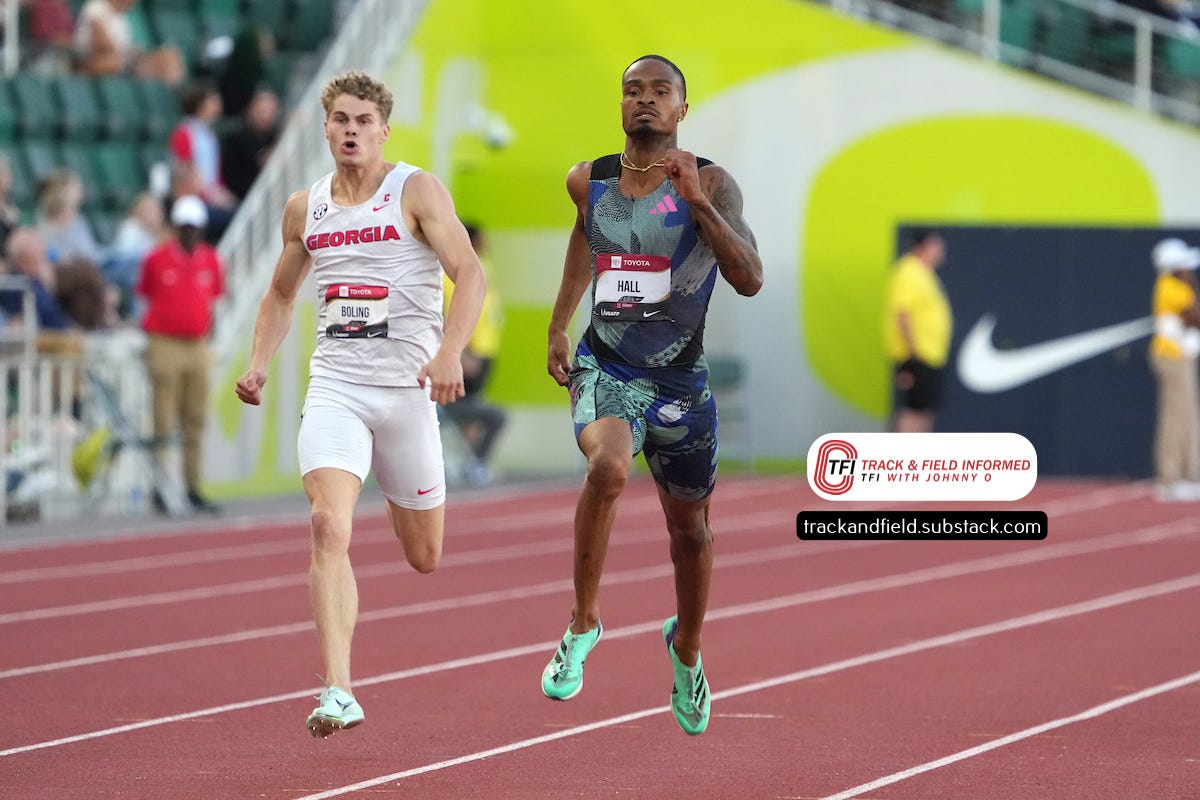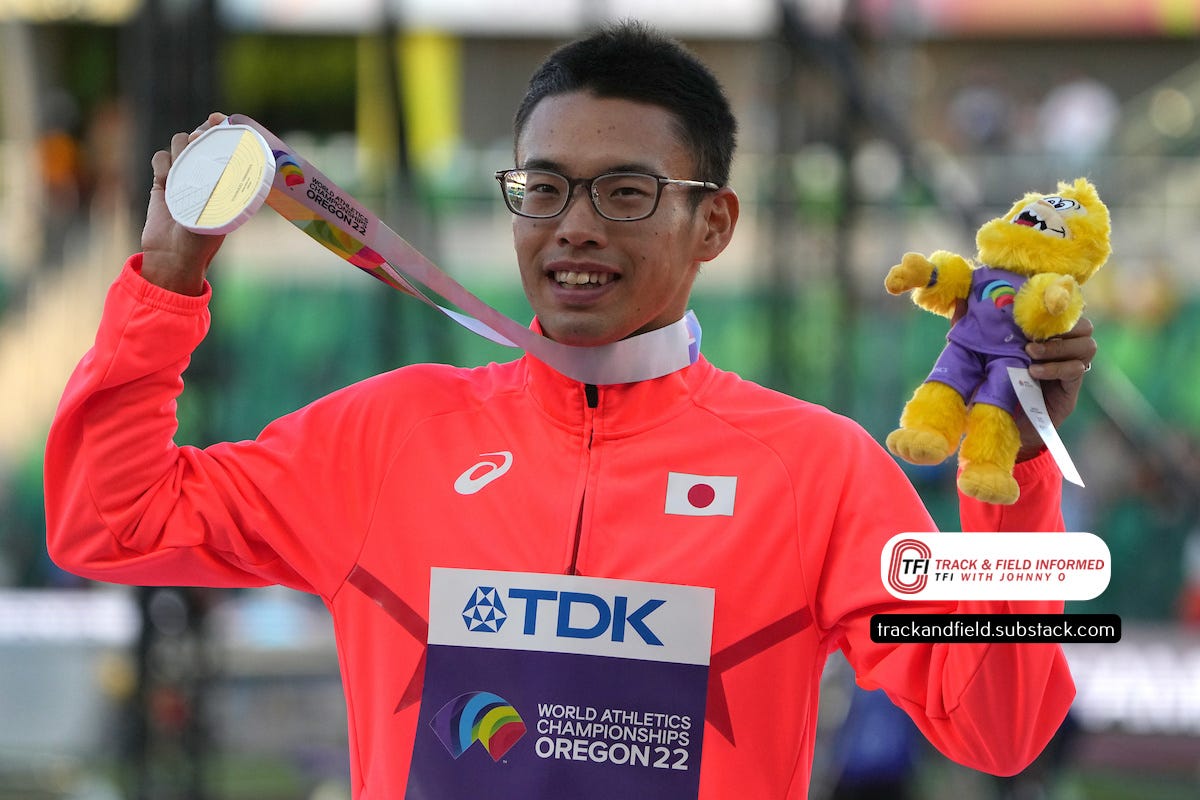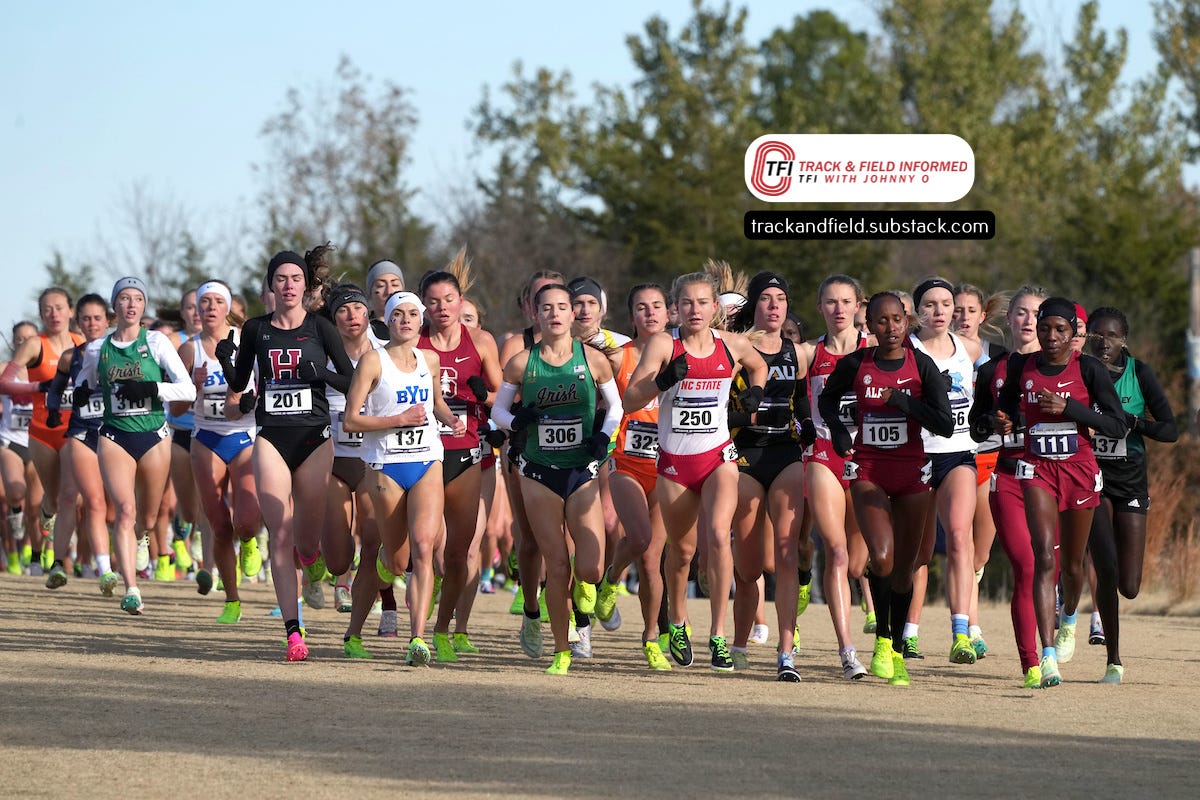Week in Review: Interesting year ahead
Unusual Diamond League schedule, inaugural Grand Slam Track meets set for 2025

For the first time since 2019 when the World Athletics Championships were staged in Doha, Qatar, from Sept. 27 to Oct. 6, the 2025 Diamond League season will conclude before the staging of a global title meet in the sport of track and field.
That became official on Oct. 2 when the Diamond League released its schedule for next year.
The schedule, which will include 14 one-day meets and a concluding two-day competition, will begin on April 26 with a season-opening meet in Xiamen, China, and conclude with the Diamond League Final at the Weltklasse competition in Zurich on August 27-28.
The Diamond League Final has often been held three to four weeks after the conclusion of the Olympic Games or World Championships. But that will not be the case next year as the World Athletics Championships will be contested in Tokyo from Sept. 13-20.
Following the season opener in Xiamen, the second Diamond League meet will be held in Suzhou, China, on May 3, followed by meets in Doha on May 16, Rabat, Morocco, on May 25, Rome on June 6, Oslo on June 12, Stockholm on June 15, and Paris on June 20.
The ninth Diamond League meet of the season will be the Prefontaine Classic in Eugene, Oregon, on July 5, and it will be followed by meets in Monaco on July 11, London on July 19, Chorzow, Poland, on August 16, Lausanne, Switzerland, on August 20, and the Memorial van Damme in Brussels on August 22.
It will be interesting to see if the staging of the Diamond League Final before the World Championships affects athletes’ performances in the former meet.
In typical years, the Diamond League Final serves as the concluding competition of the season for many of the world’s top performers, who compete for one last time before heading into the off-season.
But with athletes planning to peak in next year’s World Championships in Tokyo, they might not be as sharp and finely tuned for the Diamond League Final as they would have been when that meet was contested two to three weeks after the global title meet or the Olympic Games.
A new twist: Next year will also mark the debut of Grand Slam Track, a first-of-its kind, four-meet tour that is the brain-child of four-time Olympic gold medalist Michael Johnson.
GST is designed to pit the top track performers in the world against one another in four meets — referred to as Slams — each season.
The inaugural meet is scheduled to take place in April, with the other three competitions being held during the summer. The dates and sites have yet to be announced, but GST has stated that one of the meets will be in Los Angeles, one will be in another American city, and the other two will be staged in two “international” cities.
Grand Slam Track will consist strictly of track events and will pit performers against each other in the following categories: short sprints (100/200), long sprints (200/400), short hurdles (100 or 110 hurdles/100), long hurdles (400 hurdles/400), short distances (800/1,500), and long distances (3,000/5,000).
Each Slam will be held over three days, with each competitor running in the two events in their designated category to determine an overall champion for that meet. The winner will be awarded $100,000, with the runner-up receiving $50,000, and the third-place finisher winning $30,000.
The remaining prize money for the fourth- through eighth-place finishers will be awarded on a $25,000-$20,000-$15,000, $12,500-$10-000 basis.
As an example, Quincy Hall of the U.S., Matthew Hudson-Smith of Great Britain, and Muzala Samukanga of Zambia, the top three finishers in the men’s 400 meters in the Olympic Games in Paris, have signed contracts with GST to be Grand Slam Racers in the long sprint category.
With that being the case, they are contractually committed to compete in all four Slams in both the 400 and the 200.
Five other competitors will be in each of those races, with one of them being another still-to-be-signed Racer and four of them being Grand Slam Challengers, athletes who will be selected on a meet-by-meet basis and receive appearance fees for competing in each Slam and be eligible for prize money.
Based on an athlete’s finish in the two races in each Slam, an overall champion will be named in each of the 12 categories mentioned previously. Performers will be awarded points on a 10-8-7-6-5-4-3-2-1 basis.
If there happens to be a tie in the overall standings after the two events, an athlete’s cumulative time in both races will serve as the tiebreaker.
Each Slam will award overall titles in the 12 categories. However, no championships will be awarded based on athletes’ finishes in all four Slams.
While it’s easy to envision athletes competing in both the 100 and 200, 400 hurdles and 400, and 800 and 1,500 during a three-day Slam, it’s going to be very interesting to see how competitors perform when they are required to run a 3,000 and 5,000 during that same period.
Add Grand Slam Track: While certain aspects of Grand Slam Track are still quite fluid, the list of performers that have signed contracts with GST is an impressive one that includes Paris Olympic gold medalists — as well as Americans — Sydney McLaughlin-Levrone, Masai Russell, Quincy Hall, and Cole Hocker.
McLaughlin-Levrone, the two-time Olympic champion and the six-time world record-setter in the women’s 400-meter hurdles, was the inaugural signee with GST back in June. Russell, Hall, and Hocker have all signed since winning Olympic titles in the women’s 100 hurdles, men’s 400, and men’s 1,500, respectively.
While McLaughlin-Levrone is no doubt the biggest name to sign with GST, the organization has contractual agreements with all three medalists from the Olympic Games in the women’s 100 hurdles, and in the men’s 400 and 1,500.
In addition, Kenny Bednarek and Fred Kerley have signed to take part in the men’s short sprints category, as has fellow American Melissa Jefferson in the women’s short sprints.
Bednarek won his second consecutive Olympic silver medal in the 200 in Paris, and Kerley and Jefferson won bronze medals in the men’s and women’s 100, respectively.
Two other GST signees are Alison dos Santos of Brazil and Clement Ducos of France in the men’s long hurdles category.
Dos Santos won his second consecutive Olympic bronze medal in the men’s intermediate hurdles in Paris and Ducos finished fourth in that event.

Favorites prevail: Toshikazu Yamanishi of Japan and Antonella Palmisano of Italy, two performers who have each won three global championship medals in the 20-kilometer walk, posted runaway victories at half that distance in the III GP Internacional Madrid March Silbo Telecom race in Madrid on Sunday.
Yamanishi, the gold medalist in the men’s 20-kilometer walk in the 2019 and ’22 world title meets, timed 40:00 in the Spanish capital while finishing well ahead of Francesco Fortunato of Italy, who placed second in 40:18.
Diego Garcia of Spain finished third in 40:44, followed by Gianluca Picchiottino of Italy in 40:49 and Matheus Correa of Brazil in 41:15.
Palmisano, the 2021 Olympic champion in the women’s 20-kilometer walk, clocked 44:02 for the 10-kilometer distance in Madrid. She was followed by Mariia Sakharuk of Ukraine in 45:03, Noelia Vargas of Costa Rica in 45:17, and Raquel Gonzalez of Spain in 46:35.
Sandra Lorena Arenas of Colombia placed fifth in 47:03 after having finished fourth in the 20-kilometer walk in the Olympic Games in Paris on August 1.
The pace during the first half of the men’s race was not particularly brisk as Yamanishi, Fortunato, and Garcia came through the halfway point in 20:21. But 2021 Olympic bronze medalist Yamanishi had taken control of the contest after covering the sixth kilometer in 3:55 and the seventh in 3:51.
Although the 28-year-old Yamanishi slowed some during the final three kilometers of the race, he nonetheless covered his final 5,000 meters in 19:39.
“The circuit is tough as it’s always uphill or downhill and it was a windy day, but I’m in fine form and managed to win,” Yamanishi said in a World Athletics post. “This has been a difficult season for me as I couldn’t defend my Olympic medal in Paris, but I was training at altitude this summer in the company of Massimo Stano and that was key to being in good shape now.
“Obviously I only have eyes for the Tokyo World Championships next September, where I would like to complete a hat trick of world titles.”
After a lead group of five walkers covered the first kilometer of the women’s race in 4:25, Palmisano and Sakharuk were clear of everyone else when they came through 3,000 meters in 13:00. However, the 33-year-old Italian broke away from the Ukrainian midway through the fourth one-kilometer loop and she had a 23-second lead when she came through the halfway point in 21:45, followed by Sakharuk in 22:08, and by Vargas in 22:12.
Although Palmisano covered the second half of the race a half-minute slower than the first, the winner of the European title in June finished the contest with a 61-second margin of victory.
“This is my last competition of the year and I’m happy to finish with a win after my setback at the Paris Olympics where I had Covid a few days prior to the race,” Palmisano said in a World Athletics post. “My primary goal next season will be the Tokyo World Championships.”
Palmisano previously won bronze medals in the 20-kilometer walk in the 2017 and ’23 World Athletics Championships.
Depth prevails: BYU had two of the top four finishers, but Northern Arizona University won a relatively tight three-team battle for first place in the women’s blue division race of the Joe Piane Invitational at Notre Dame last Friday.
Senior Lexy Halladay-Lowry of BYU placed first with a time of 15:57.5 over the 5,000-meter course at Burke Colf Course and sophomore teammate Jenna Hutchins finished fourth in 16:14.1 for the Cougars, who entered the meet as the No. 5-ranked team in the U.S. Track & Field and Cross Country Coaches Association (USTFCCCA) poll. But No. 2 Northern Arizona had five of the top 13 finishers while recording a 52-65 victory over BYU.
Notre Dame, the No. 3 team in the USTFCCCA poll, finished third with 70 points, followed by Liberty with 189 and Boise State with 204.
Sophomore Carrie Baloga paced Northern Arizona with a seventh-place finish in 16:16.2 and senior teammate Maggie Congdon placed ninth in 16:23.6 for the Lumberjacks.
The team’s No. 3 and 4 finishers were juniors Nikita Moore in 11th place in 16:26.6 and Alex Carlson in 12th place in 16:31.1. Freshman teammate Ava Mitchell rounded out the scoring for NAU when she finished 13th in 16:31.3.
On the individual side, Texas Tech sophomore Juliet Cherubet finished second in 16:03.5 and Oklahoma freshman Leah Jeruto placed third in 16:06.7.
Host Notre Dame was led by seniors Siona Chisholm and Emily Covert, who finished fifth and eighth, respectively, with times of 16:15.0 and 16:22.5.
Depth prevails II: Host Notre Dame won the men’s team title in the blue division race of the Joe Piane Invitational with a performance that was very similar to Northern Arizona’s victory in the women’s contest as the Fighting Irish had five of the top 14 finishers.
Led by the eighth-place effort of Ethan Coleman, No. 9-ranked Notre Dame had five of the top 14 finishers — as well as a miniscule gap of 7.2 seconds between its’ No. 1 and 5 runners — while winning its second consecutive title with a 55-68 victory over No. 4 Northern Arizona.
Cal Baptist, the No. 29-ranked team in the national poll, placed third with 112 points, followed by Wyoming with 150 and No. 30 Michigan State with 167.
While freshmen Ernest Cheruiyot of Texas Tech, Evans Kirui of Washington State, and Patrick Kiprop of Cincinnati placed first, second, and third, respectively, with times of 22:20.3, 22:24.7, and 22:27.0, over the 8,000-meter course at Burke Golf Course, Coleman clocked 22:49.0 for Notre Dame.
Fellow sophomores Daelen Ackley and Izaiah Steury were Notre Dame’s No. 2 and 3 runners while finishing in 10th and 11th place in times of 22:51.7 and 22:52.1.
Freshman Drew Griffith, last year’s Foot Locker cross country champion as a senior for Butler High in Pennsylvania, placed 12th in 22:53.9 for the Fighting Irish and senior Carter Solomon was Notre Dame’s No. 5 scoring runner when he finished in 14th place with a time of 22:56.2.
Northern Arizona, the runner-up in last year’s NCAA championships after winning six of the previous seven titles, was paced by the fourth-place finish of senior David Mullarkey, who ran 22:36.9. However, the Lumberjacks’ No. 2 runner was sophomore Justin Keyes in 13th place with a time of 22:54.9.
That left him a place behind Notre Dame’s No. 4 runner and a place in front of the Fighting Irish’s No. 5 scorer.

On the PED front: Emmaculate Anyango Achol of Kenya, the second-fastest woman in history over 10 kilometers on the road, has been provisionally suspended by the Athletics Integrity Unit (AIU) for a doping violation.
According to the AIU, she was suspended for the presence/use of a prohibited substance (testosterone and EPO).
Kenyan Agnes Jebet Ngetich and Ayango became the first two women to run under 29 minutes for 10 kilometers on the road in January when they clocked 28:46 and 28:57, respectively, in a race in Valencia, Spain.
Those times had crushed the previous world record of 29:14 that had been set by Yalemzerf Yehualaw of Ethiopia in 2022.
The 24-year-old Anyango later finished fourth in the World Athletics Cross Country Championships in Belgrade, Serbia, on March 30 before running a track personal best of 30:06.43 for 10,000 meters while finishing sixth in the Prefontaine Classic in Eugene, Oregon, on May 25.
In her most recent performance, she ran 49:18 to finish second in a 15-kilometer race in Utica, New York, on July 14.
Anyango could be subject to a four-year suspension if she is found guilty of the violation.
In memory: Kipyegon Bett of Kenya, the bronze medalist in the men’s 800 meters in the 2017 World Championships, died on Sunday. He was 26.
Bett, the World U20 champion in 2016, had run a career best of 1:43.76 in September of that year when he was 18. But he was issued a four-year suspension by the Athletics Integrity Unit (AIU) in August of 2018 for refusing to submit a sample for testing purposes and later testing positive for erythropoietin (EPO), a banned substance.
Although his ban ended in 2022, his only race since then had been a 56.76-second clocking in the 400-meter intermediate hurdles in March of that year.
In a bbc.com post, Bett’s sister, Purity Kirui, told BBC Sport Africa that her brother “had been sick, complaining of stomach pains for about a month. The doctors said he had a liver problem and he had been in and out of the hospital.”
She added that she had gone to see him in the hospital on Sunday and Bett had told her he was in pain.
“He told our dad, who is a pastor, to pray for him because he didn’t feel he would survive and after 12 noon he died. We tried everything to save him, but he left us. It’s very painful.”
Kirui, who won the women’s 3,000-meter steeplechase in the 2014 Commonwealth Games, said further that Bett had started to drink a lot after he was banned and suffered from depression.
“We tried to get him to stop drinking, but whenever we wanted to take him to rehab he would disappear from home for days.”


